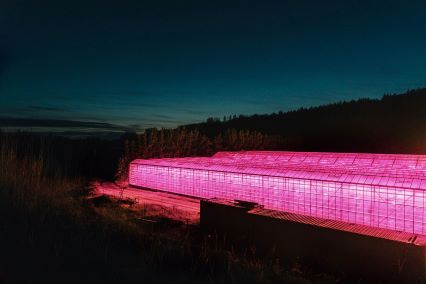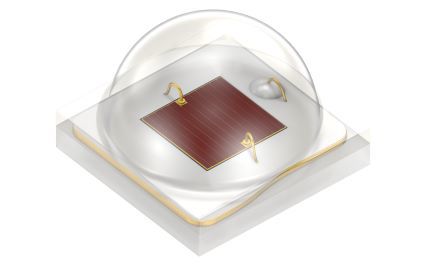Growers are turning to high-quality sunlight substitutions and, consequently, LED manufacturers such as ams OSRAM, Everlight, Cree and Samsung are developing horticulture lighting solutions to improve plant cultivation.
The demand for lighting technology is being driven by a combination of elements including: changing weather patterns which means that farmers are turning to horticulture lights in order to maintain a more controlled agricultural environment; the need to improve crop yields; and a requirement for more sustainable energy usage. Innovative LED lighting applications are also being used to address the needs of new forms of farming such as vertical and indoor farming.
According to Janick Ihringer, VP and General Manager of the Illumination Business Line at ams OSRAM, “Two megatrends are driving the market. One is urbanisation and the second, is health. In terms of urbanisation there is a drive towards producing more food locally, especially in countries in northern Europe where perhaps there isn’t enough natural light – hence the demand for artificial lighting. The other issue is people’s health. People want a greater sense of wellness and so want to eat more healthily but to do so in an environmentally friendly way. It means saving energy, cutting back on pesticides and making better use of limited resources.”
LEDs are produced for many markets and competition among manufacturers is driving innovation and delivering much greater product choice. LED lighting for horticulture is a fast-growing market and is used to deliver fresher, more nutritious fruits and vegetables.
“There is a lot of investment on greenhouses, city and vertical farms. Much of our work involves replacing incumbent technology but also in adding new forms of artificial light,” says Ihringer. “The use of controllable illuminance and spectrum means that LEDs can be used to cultivate a broad variety of different crops, from tomatoes, herbs and greens to cucumbers and cannabis.
“Using artificial light in a controlled way it’s possible to create multilayered, stacked farms that are more energy efficient.”
In terms of disease management lighting has a crucial role in the controlled environment of vertical farms, where pesticides tend not to be used. “Lighting can be used to disinfect and supress fungi growth,” Ihringer explains.

Latest LED fixtures
Considerable research has gone into how plants need a certain amount of light in different wavelengths for an optimal growth and special luminaires combine red, blue and white LEDs, depending on the light recipe required for the plant.
Many LED fixtures have a lambertian primary lens and no secondary optic, or a simple glass cover, and this can lead to hotspots with high concentrations of light directly under the luminaire resulting in inconsistent yields.
“Our Oslon Square Batwing has a special shape of optics to enable customers to simplify their designs and reduce the number of fixtures required,” explains Ihringer.
When it comes to horticulture lighting growers often face light uniformity issues with the Pitch-to-Distance ratio and growers tend to close the lighting gaps by deploying more luminaires or simply accept that yields will be lower.
“The Batwing is a primary optic that enables a special radiation pattern of light that looks like wings. The wide beam angle of 140° and the rectangular shape of light distribution enables higher uniformity and an optimum utilisation of space in greenhouses. The wider angle also allows for a larger distance between the luminaires and a possible reduction of fixtures,” says Ihringer.
“In addition, plants have variation in their growing stages and so will require different spectrum. We can employ sensors to detect the spectrum being offered and therefore what is missing.”
Ams OSRAM has just extended its OSLON Optimal family of horticultural lighting LEDs with a new 640 nm Red LED.
“This enables indoor farmers to produce faster and healthier plant growth,” says Ihringer. “It provides a broader coverage of the red portion of the spectrum and this 640 nm Red LED joins our 660 nm Hyper Red and 730 nm Far Red and is available alongside a 450 nm Deep Blue LED and a horti white LED.”
According to Ihringer its common practice in horticulture to illuminate crops with a mix of LEDs for plants that require full-spectrum light.
“There’s a vast amount of research going into spectrum light as it has significant implications for particular plants and plays an important part in LED development. Initially the focus was on white light but today we have realised that different parts of the spectrum can influence not only growth but taste and quality as well.
“In fact, research conducted by Wageningen University on behalf of ams OSRAM has shown that a double red peak (640 nm and 660 nm) in combination with horti white can increase the dried biomass level in indoor growing environments, while the use of Optimal Red was found to prevent photo bleaching in some plant varieties,” explains Ihringer. “Experience shows that it can also prevent the incidence of fungal and bacterial infection in leafy greens such as basil.”

Ams OSRAM is not alone in introducing new products for horticulture lighting. Polymatech unveiled its next-gen horticulture LED grow light in January of this year which includes monochromatic LEDs and Ravaye full-spectrum packages and modules.
These products are intended to help vertical farming, greenhouses and lighting for horticulture applications and they offer a broader light spectrum for healthier and faster plant growth, improving farming environments and reducing lighting system costs.
In April last year, Samsung introduced ‘Plant-Centric Spectrum LEDs’, such as the LM301H EVO for indoor farming. This has a light source with a 437 nm spectral peak to improve plant growth and enhance crop quality. The LED was able to demonstrate dramatic improvements to photosynthesis over existing horticulture lighting solutions, resulting in better plant growth.
“Cost is obviously another important issue when we talk about horticultural lighting,” concedes Ihringer. “Our new OSLON Optimal Red products can play an important part in raising energy efficiency and reducing the cost of electric power in all horticultural lighting applications, including greenhouse top-lighting and inter-lighting, and vertical farming. Producing 3.53 µmol/J, it achieves very high wall plug efficiency of 66.3 %. The LED’s radiant flux is 485 mW, and photon flux is 2.58 µmol/s.”
LEDs also produce much less heat than other lighting fixtures - heat is considered waste in most in-door farms and is removed by an air conditioner or fan. Consequently, by using LEDs growers can reduce energy consumption as well as reduce waste.
According to Ihringer data collection and processing are being looked at to help with the more efficient use of lighting.
“We provide the sensors and lighting components, but data and its use is certainly an area of growing interest and a useful tool in optimising growth patterns.
“AI has an important future role in the industry and can be used to generate more precise data in terms of plant growth, health and feed optimisation – but it’s not being widely deployed as yet.”
As ams OSRAM has shown LED lighting providers are developing a wide range of horticultural products and are demonstrating the benefits of LED horticultural lighting.
Increased and more sustainable food production are going to be critical issues as populations continue to grow, while at the same time there is less agricultural land available and more unreliable weather conditions to contend with.
To address these challenges the horticultural market can expect to see much more product innovation and collaboration between growers, technologists and academia.













